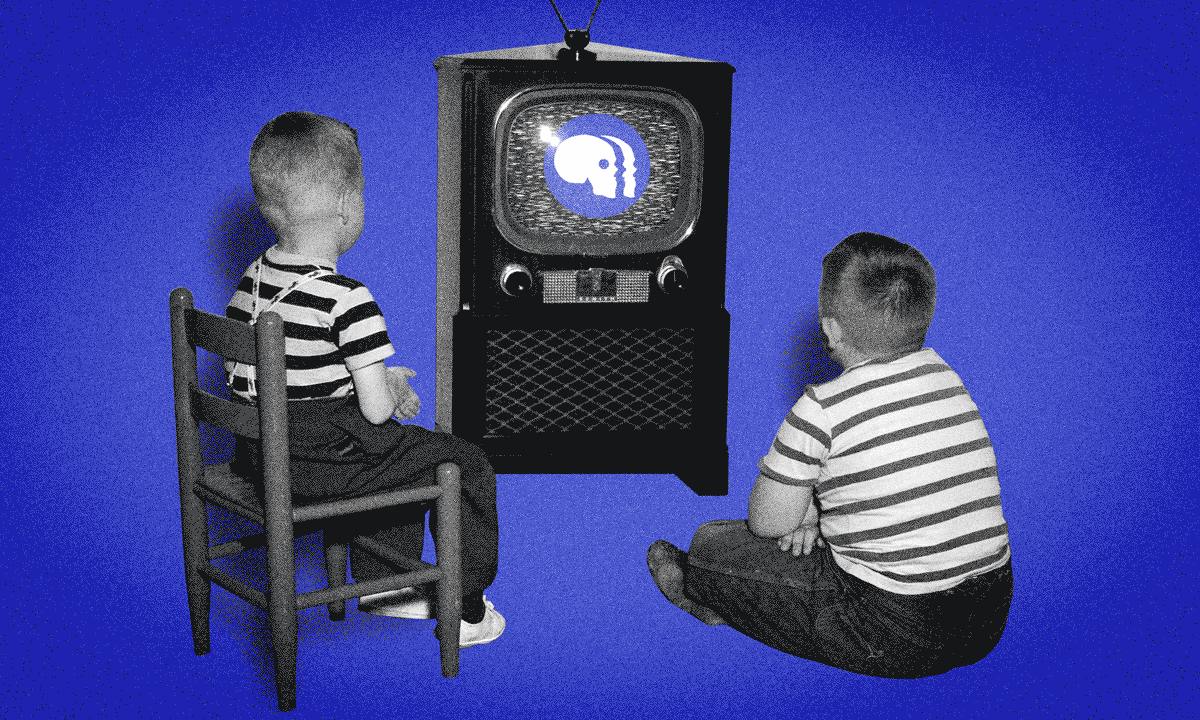The Future of Children’s Programming After Federal Cuts to Public Media
The nation needs a strategy for children’s media that draws from the trusted legacy of public media and leverages today’s most promising tech tools.

Join our zero2eight Substack community for more discussion about the latest news in early care and education. Sign up now.
When I drive my grandson Henry to preschool, he scrolls through a Ms. Rachel video on his tablet with ease and purpose. For today’s toddlers, digital media isn’t a special treat — it arrives with breakfast. As a grandparent and an early learning expert with more than two decades in the field of children’s media, I see the promise and the peril of this reality: Some families enjoy high-quality, guided educational experiences in measured doses; others are served constant, age-inappropriate ad-laden content that distracts more than it teaches.
With federal funding for PBS and the Corporation for Public Broadcasting now wiped out, one of the few trusted, equity-driven sources of children’s media is seriously wounded. These cuts challenge not only the families and educators who rely on PBS Kids, but also the broader media landscape that risks becoming even more fragmented, commercial and inequitable.
The cuts present a critical juncture and potential pivot point. How educators, media makers and policymakers respond will shape not just children’s school readiness, but the civic health, creativity and curiosity of a generation raised in the shadows of algorithmic platforms.
To meet the moment, policy leaders and educators must move beyond screen time limits and cell phone bans — and focus instead on a long-term vision rooted in shared public interest values, powered by human connection and guided by standards that prioritize children’s well-being from the start.
Babies and Toddlers Are Using Screens — Now What?
Recent studies and scholars have documented the growing use of screen media among infants and toddlers. The Common Sense Media Census, a study of media use for children from birth through age 8 conducted in 2024, showed that the average infant and toddler under 2 years old was spending more than an hour a day on screens, with children ages 2 to 4 using screens more than two hours daily. In Fall 2023, while I was head of learning and impact at Noggin, an interactive platform for kids ages 2 to 8, my team led a study of 400 families with children under 3 and found screen use now begins in infancy for more than 95% of families.
For overworked and under-resourced families, screens aren’t optional — they’re essential tools for navigating daily life. Platforms like YouTube, TikTok and AI bots like Baby Grok are commanding children’s attention, fueled by opaque algorithms and ad-based business models that promote addictive, low-quality content. Early media exposure can no longer be considered peripheral. Reduced federal support for PBS Kids and other public media will make that imbalance more acute unless private and philanthropic sources step up.
Reimagining Early Learning Media in the AI Era
At the same time, a major disruption in media production for kids is underway, powered by fast, cheap video production, artificial intelligence and personalized learning technologies. Legacy organizations like Sesame Workshop and PBS face pressure to keep pace with viral success stories like Ms. Rachel and Duolingo, which have shown how efficient, engaging content can reach millions.
I currently mentor entrepreneurs experimenting with how new technologies like voice recognition and artificial intelligence can support young kids. I’ve seen promising innovations that build on the foundational equity and inclusion principles popularized by public media pioneers like Fred Rogers and Joan Ganz Cooney. The ones that shine most brightly are those that reflect the original spirit of Sesame Street: equity through innovation.
The founders are prioritizing three key principles: connected learning, personalized choice and family co-viewing. Each principle recognizes that brain development is most rapid in the first five years of life, that intention for little ones can be easily scrambled by powerful algorithms and that busy parents — like it or not — have chosen to make digital and screen media a feature of daily life.
By designing products that stimulate curiosity and discourage overconsumption, media developers can encourage children to practice their “I can do it” moments out in the real world; use AI to personalize choice and guide language learning; and deliver “just in time” content to drive school readiness. Some pioneers are taking a playbook from research on Sesame Street’s power to scaffold learning via family co-viewing to create new opportunities for intergenerational play, a critical opportunity for parent-child bonding and healthy development.
These new models rely on modern ingredients, such as AI, real-time data and mobile-first, multi-platform design. In the wake of federal cuts, companies and organizations building tools to support young children’s early learning and development have a responsibility to leverage research on the value public media has brought to young children for decades and the opportunity that high-quality, tech-enabled learning can deliver.
The reality is that child development experts and educators who have been studying how kids learn and grow for decades now must confront a digital revolution powered by generative AI, immersive media and increasingly personal learning companions. This wave could either democratize access to world-class learning or cement a two-tiered system: premium, voice-based tools for the wealthy; and game-heavy, ad-driven distractions for everyone else.
“In the wake of federal cuts, companies and organizations building tools to support young children’s early learning and development have a responsibility to leverage research on the value public media has brought to young children for decades and the opportunity that high-quality, tech-enabled learning can deliver.”
Michael Levine, policy and research expert
To prevent that outcome, we need clear public standards for AI in early childhood, informed by early learning experts and advocates. “No AI bots for tots” should be an early mantra of concern for all human-centered designs for children under age 8. We also need an industry-wide commitment to ethical and responsible development of any AI-driven product designed for children that young and transparency about how AI tools are trained, and who they are designed to serve.
A National Strategy for Children’s Media
To ensure the next generation of early learning media — now introduced into the crib — are “helpmates” and parasocial role models rather than substitutes for the warm, responsive adult relationships that fuel real learning, the nation needs a clear strategy for children’s media. The strategy must safeguard the development of young children, blend the trusted legacy of public media with today’s most promising tech tools, and embrace a broad cross-sector alliance.
That strategy begins with restoring adequate funding for PBS, but public dollars alone won’t be enough. To move from patchwork to progress, I propose six coordinated actions:
First, we need a new funding stream for children’s media modeled on the public-private partnership that created the Corporation for Public Broadcasting. Backed by a consortium of philanthropies and individuals, the fund could be sustained by state and community-based financing models administered through public agencies and could galvanize public support for inclusive, research-backed media tools built for children’s developmental needs.
Second, we must establish shared standards for responsible media and AI design in early childhood. Policymakers should work with trusted early learning and development partners to create guardrails that prioritize equity and authentic learning over clicks and virality.
Third, state leaders — who are poised to wield more discretion as federal dollars devolve — should direct resources toward high-quality digital tools and educator training to better use proven public media offerings across Head Start, family child care, and pre-K settings.
Fourth, edtech leaders and investors must design learning tools and business models that prioritize trust, transparency and impact and engage in longitudinal research that tracks how digital tools close equity gaps and support healthy development.
Fifth, educators and families must recognize that they’re not just users, they are catalysts for change who can push for media that’s feedback-rich, culturally affirming and scaffolded for learning; can demand better integration between home and classroom technologies; and can shape the field by voicing what works, what fails and what’s missing.
Finally, pediatricians and health leaders must help reframe the screen time conversation from guilt to guidance. By lifting up high-quality media as a tool for overstretched families, rather than a threat, they can re-center the conversation around children’s real needs: connection, stimulation, and joy.
We’ve lingered too long in the wet cement of funding debates and in a digital marketplace where profit often outweighs purpose. The recent, and sadly predictable, federal cuts to public media should be treated not only as a wake-up call, but as a catalytic moment to act.
This will take public investment, private ingenuity, and political courage. But most of all, it will take national will: the conviction that every child, regardless of income or ZIP code, deserves access to inspiring, developmentally sound, high-quality media content that sparks curiosity, fuels learning and lifts their full civic potential.
Get stories like these delivered straight to your inbox. Sign up for The 74 Newsletter


;)
